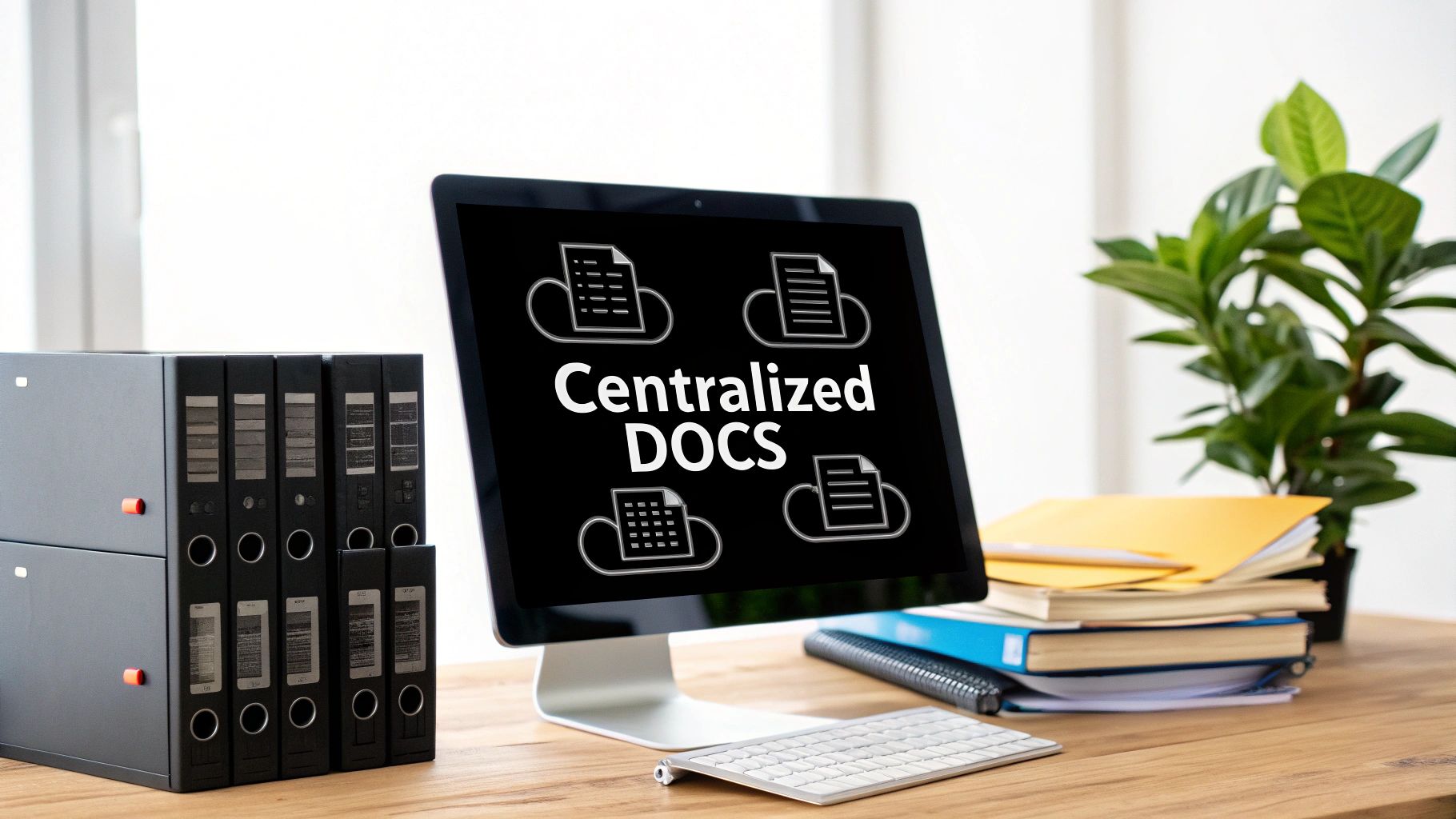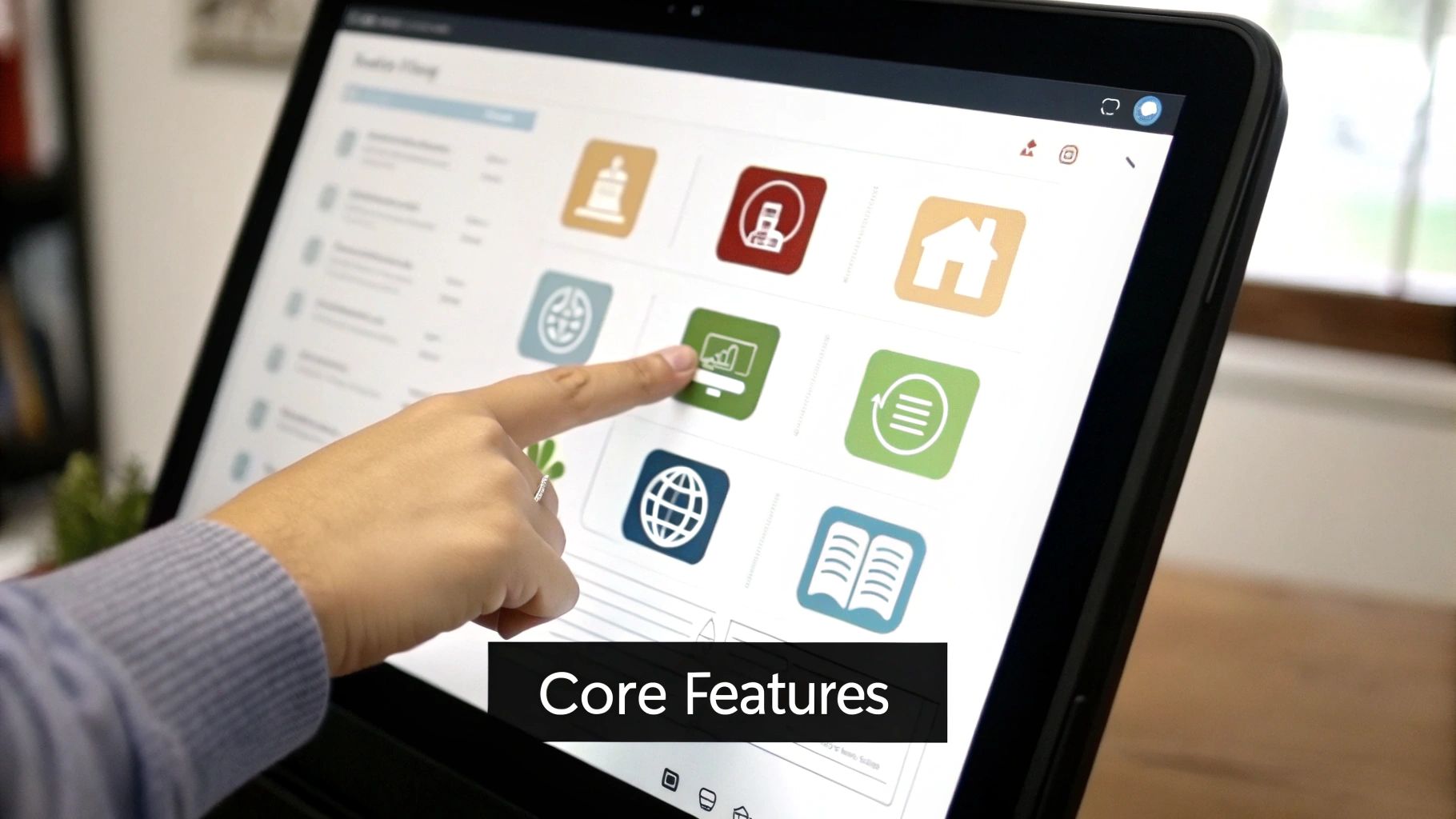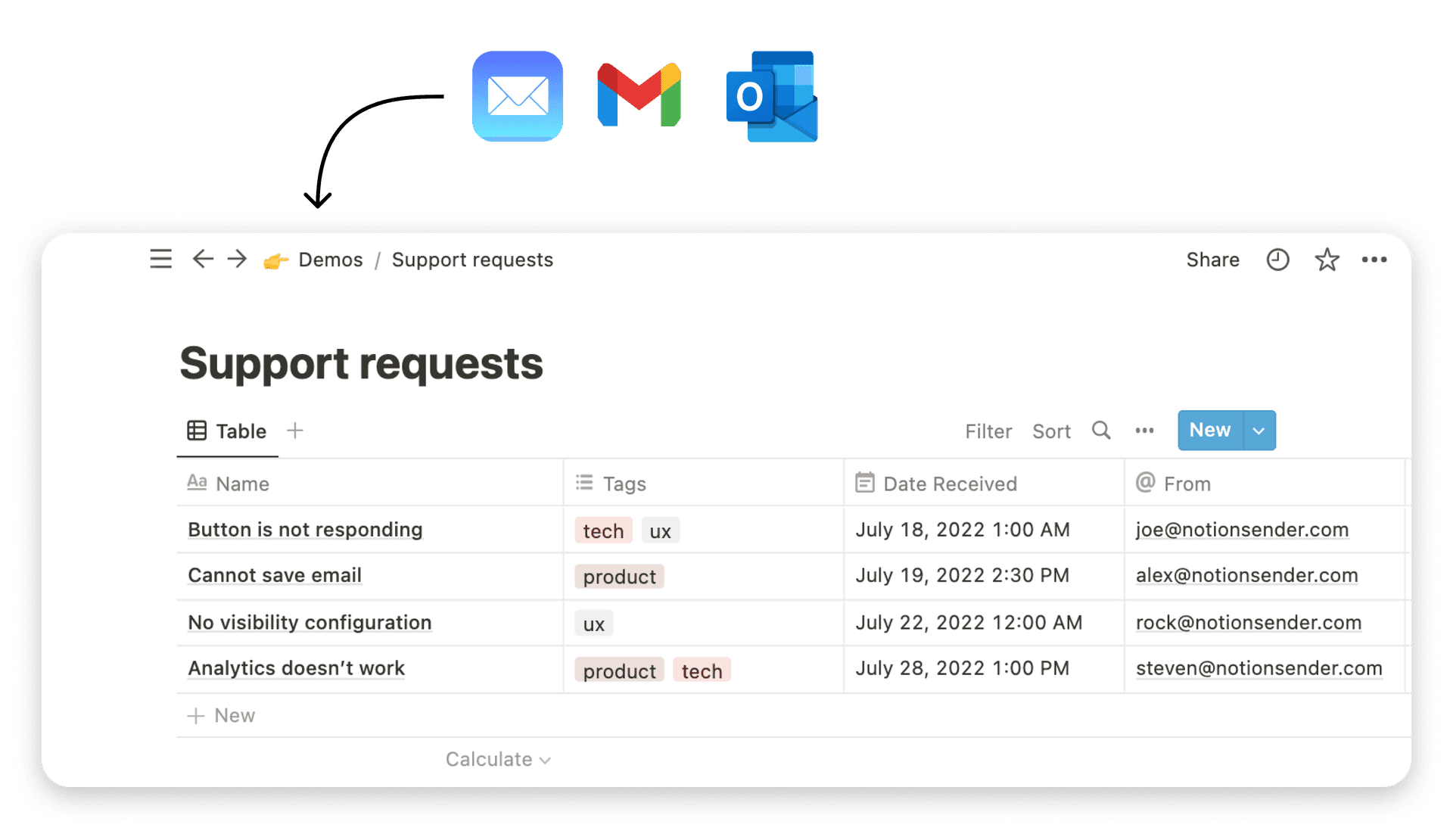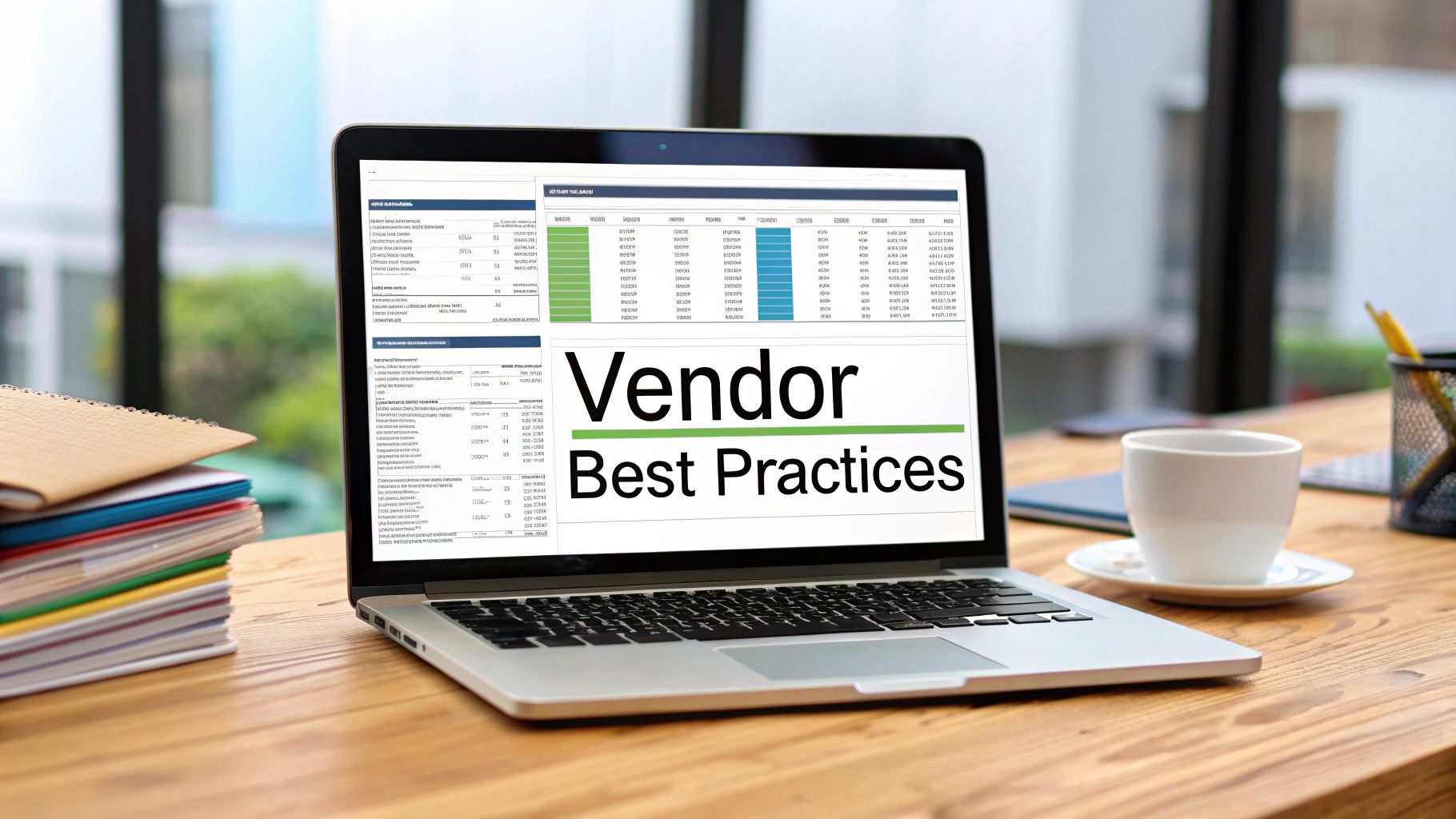Boost Efficiency with a Centralized Document Management System

Ever felt like you're on an endless scavenger hunt for a file? A contract buried in an old email thread, a project plan saved to someone's desktop, or the latest invoice floating around in a random cloud drive. It’s a familiar, frustrating story for most businesses. A centralized document management system is the cure for this digital chaos.
Think of it as the master library for your company. Instead of having documents scattered across countless locations, everything—from critical contracts to marketing materials—lives in one organized, searchable, and secure place. It’s your single source of truth.
Ending Digital Chaos With Centralized Document Management
Picture a library where books are stashed in different buildings, multiple copies of the same book exist (and no one knows which is the latest edition), and there's no catalog to be found. That's exactly how many businesses handle their digital files. This disorganization creates constant friction, forcing teams to waste precious time hunting for information that should be at their fingertips.
The fallout from this digital mess is bigger than you might think. A recent study found that the average knowledge worker spends a staggering 2.5 hours per day just searching for information. That's a silent productivity killer quietly draining your team's energy and your bottom line.
This visualization perfectly captures the digital clutter so many organizations are drowning in.

Without a central system, critical information gets trapped in silos. Collaboration becomes a chore, and making quick, informed decisions feels nearly impossible.
The True Cost of Disorganization
Beyond just lost time, a scattered, decentralized approach to files opens the door to serious risks. Version control becomes a nightmare. A designer might use an old logo, a legal team could reference an outdated contract, or an engineer might work from obsolete blueprints. These aren't just hypotheticals; they're costly mistakes that happen every day.
Security is another huge worry. When sensitive documents are saved on personal laptops or shared through unsecured email chains, the risk of a data breach skyrockets.
This is where a centralized document management system completely changes the game.
To make this crystal clear, let's compare the old way of doing things with the new, centralized approach.
Decentralized vs Centralized Document Management
| Aspect | Decentralized System (The Old Way) | Centralized System (The New Way) |
|---|---|---|
| File Location | Scattered across emails, desktops, various cloud drives. | One single, secure, and organized repository. |
| Version Control | Chaotic. Multiple versions exist, causing confusion and errors. | A single source of truth. Everyone accesses the latest version. |
| Accessibility | Difficult. Depends on who has the file and where they saved it. | Instant access for authorized users from anywhere. |
| Security | Low. High risk of data breaches and unauthorized access. | High. Granular permissions and robust security protocols. |
| Collaboration | Inefficient. Requires emailing files back and forth. | Seamless. Teams can work on the same document in real-time. |
| Compliance | Hard to track. Lacks clear audit trails. | Simplified. Automatic audit trails track all activity. |
The difference is night and day. Adopting a centralized system isn't just about tidying up your files; it's about building a more resilient and efficient foundation for your business.
By bringing order to your digital assets, you're not just cleaning up files; you're building a more resilient, efficient, and secure operational foundation for your entire business.
Why Centralization Is Gaining Momentum
The shift toward structured document control isn't just a fleeting trend—it's a massive market movement. The global document management system market is expected to rocket from USD 9.34 billion in 2025 to over USD 37.13 billion by 2035. This explosive growth is driven by the urgent need for better digital workflows and stricter data protection.
For companies looking to truly get ahead, especially those focused on streamlining operations for creative businesses, this is a critical step. A central system puts an end to the daily information hunt and gives your team back the focus they need to do their best work.
What You Really Gain: The Core Benefits of a Central Hub
Bringing in a centralized document management system isn't just about tidying up your digital files. It’s a strategic move that pays you back in real-world efficiency, tighter security, and a healthier bottom line. When you finally move past the chaos of scattered files, you start to see some tangible advantages that solve the most frustrating headaches in day-to-day business.
These benefits aren't isolated; they ripple out across the whole company. The finance team gets instant access to invoices, and project managers can coordinate with remote team members without a hitch. A central hub for your documents acts as a business accelerator, turning painful bottlenecks into smooth, predictable workflows.
Fortify Your Security and Simplify Compliance
In a world where data breaches are a constant threat, locking down your sensitive information is non-negotiable. A centralized system is like a digital fortress for your most critical documents. It replaces the gaping vulnerabilities of unsecured emails and personal drives with robust security you can actually manage.
The secret sauce here is granular access controls. This fancy term just means you get to decide exactly who can see, edit, or share any given document or folder. Picture this: you're prepping for a financial audit. Instead of a mad scramble to pull files from ten different places, you can grant the auditor temporary, read-only access to one specific, organized folder. It’s not just simpler; it shows you're in complete control.
Here’s how it breaks down:
- Role-Based Permissions: You make sure employees only access what they need for their job. This keeps confidential HR files, client contracts, and financial records away from prying eyes.
- Complete Audit Trails: Every single action—from someone just opening a file to making an edit—is logged. This creates a solid, unchangeable record that's gold for complying with regulations like GDPR or HIPAA.
- Centralized Backups: Protecting your data from a hard drive crash or a cyberattack is a whole lot easier when all your important documents are in one secure place that gets backed up regularly.
A centralized system flips the script on compliance. Instead of a stressful, reactive fire drill, it becomes a proactive, manageable process. With clear audit trails and controlled access, proving you're following the rules becomes straightforward.
This kind of structured approach slashes your risk. Just look at Huntsman Corporation, a global manufacturer that saw a 5% reduction in their information management expenses after implementing a comprehensive system. They gained better control and security across 30 countries.
Reclaim Lost Hours with Powerful Search
Seriously, how much time does your team burn just trying to find the right document? The answer is usually more than you want to admit. A central repository turns that wasted time into productive work by making information pop up instantly. It's the difference between a messy, overflowing closet and a perfectly organized library where every book is exactly where it should be.
Modern systems have search tools that are light-years beyond just matching a filename. They can scan the full text inside your documents and even use Optical Character Recognition (OCR) to find keywords in scanned PDFs and images.
Think about a marketing manager who needs to find every contract from the last three years that mentions a specific campaign. That task, which used to be a multi-hour detective mission through old emails and shared folders, now takes seconds. This kind of instant access keeps decisions and projects moving forward without the drag of unnecessary delays.
Eliminate Costly Errors with Version Control
One of the biggest dangers of having files scattered everywhere is the version control nightmare. When multiple versions of the same document are floating around, it's not a matter of if someone will use the wrong one, but when. And that leads to expensive mistakes, confused clients, and a ton of wasted effort.
A centralized document management system puts an end to this by creating a single source of truth.
With solid version control, you know everyone is always working from the most current document. When a file gets updated, the old versions are archived automatically, giving you a clear history of every change. If a colleague in another time zone updates a project proposal, you can be 100% sure you’re looking at the latest draft—not the one from three days ago. This simple function prevents the kind of errors that can derail projects, damage client relationships, and force you to do the work all over again.
What Makes a Document Management System Powerful?

Let’s be honest, not all document management platforms are the same. Picking the right one is like shopping for a car—you have to look under the hood to see what really powers the machine. Otherwise, you might end up with a tool that creates more problems than it solves.
The diagram above gives you a bird's-eye view of how a solid system works, from capturing a file to archiving it safely. But what are the non-negotiable features that separate a basic cloud folder from a true management powerhouse?
Let's break them down.
Tracking Every Change with Version History
One of the most valuable features is version control. Think of it as a time machine for your documents. Every time someone makes a change, the system automatically saves a new version without you having to lift a finger.
This completely eliminates the chaos of files named "Final_Contract_v3_Final_Final." Instead, you have one master document. If you ever need to see who changed what or roll back to an earlier draft, you can access a complete, unchangeable history in just a few clicks. It’s absolutely critical for collaborative projects and legal documents where you need a clear audit trail.
Putting Approvals on Autopilot with Workflows
Imagine a system where documents move themselves from one person to the next. That’s the magic of automated workflows. Instead of manually emailing a contract to a manager, then to legal, then to finance, you build a custom path that does it all for you.
You define the steps, and the system automatically pings the right person at each stage. As soon as one person signs off, the document instantly moves to the next person in line.
Workflows transform your internal processes from a series of manual handoffs into a smooth, automated, and trackable assembly line. This drastically reduces delays and ensures no step is ever missed.
This is a game-changer for things like:
- Invoice Processing: Routing invoices from submission to approval and payment without any manual follow-up.
- Contract Reviews: Making sure legal documents get eyes from every necessary department before being finalized.
- New Hire Onboarding: Guiding HR paperwork through all its required reviews and signatures.
Finding Needles in Haystacks with Advanced Search
A central library of documents is only useful if you can find what you're looking for. Modern systems go way beyond simple filename searches. They use powerful indexing engines and Optical Character Recognition (OCR) to make every single word inside every document searchable—even in scanned images and PDFs.
This means you can find a specific clause inside a 50-page scanned contract from five years ago just by typing in a keyword. It turns your entire archive into a fully searchable knowledge base, saving countless hours of manual digging. And with AI entering the picture, these tools are getting even smarter, automatically tagging documents to cut down on manual work. It's a big reason why the market for cloud platforms is expected to grow at a 17.4% CAGR through 2030. You can learn more about how AI is shaping document management trends on invensis.net.
Protecting Information with Role-Based Permissions
Protecting sensitive information is everything. Role-based access control is the feature that lets you set precise permissions for every user, team, or department. You get to decide who can view, edit, download, or share specific files and folders.
For example, your finance team can have full editing access to financial records, while the marketing team is restricted to view-only. This kind of granular control is essential for protecting confidential client data, HR files, and any proprietary company information. It makes sure people only see what they need to see.
Creating a Connected Workplace with Integrations
Finally, a powerful system doesn't live on an island. It has to connect with the other tools you use every single day. Integrations are what allow your document management system to talk to your CRM, project management software, and email.
This creates a truly connected digital workplace where information flows freely between your favorite apps. For developers who want to build these kinds of custom bridges, a well-documented API is a must-have. You can see a great example of what this looks like by checking out the NotionSender API documentation, which shows how different systems can be linked together. When your tools talk to each other, you stop wasting time on duplicate data entry and create much smarter workflows.
Your Step-By-Step Implementation Roadmap
<iframe width="100%" style="aspect-ratio: 16 / 9;" src="https://www.youtube.com/embed/CVV3wgik2RQ" frameborder="0" allow="autoplay; encrypted-media" allowfullscreen></iframe>
Making the switch to a centralized document management system is a big move, but it doesn't have to be overwhelming. If you break it down into a few clear phases, the whole process becomes much smoother.
Think of it as a roadmap. A good plan keeps you from getting lost in the details and ensures you’re building something that actually works for your team. It’s less of a single, giant leap and more a series of deliberate steps toward finally getting organized.
And that journey doesn't start with software demos—it starts with an honest look at how you're working right now. You have to understand your own pain points before you can find a solution that truly fixes them.
Phase 1: Define Your Goals and Scope
Before you can build a better system, you need to agree on what "better" actually looks like. The first step is to take stock of your current document workflows. Seriously, where are the biggest headaches? Are critical files buried in endless email chains? Is version control a constant guessing game?
Talk to people in different departments to get the full picture. The struggles your sales team faces are probably different from what finance or operations deals with every day. Once you’ve mapped out the core problems, you can set some clear, measurable goals.
Your goals might look something like this:
- Cut down the time we spend searching for documents by 50%.
- Get rid of version control errors on all our client contracts.
- Automate the invoice approval process so we can shorten payment cycles by five days.
With these targets in mind, you can define the scope of the project. Are you going to roll this out to the entire company at once, or start with a single department as a pilot? A smaller, focused scope is often the secret to a successful launch.
Phase 2: Select the Right Vendor and Plan Migration
Now that you know what you need, it’s time to find the right tool. Put together a shortlist of vendors whose systems have the features that match your goals—things like automated workflows, solid security, and the right integrations are key. Don’t just sit through slick demos; ask for a trial so you can get your hands dirty and see how the software actually feels to use.
Once you’ve picked a winner, the next make-or-break step is planning your data migration. This is often the trickiest part of the whole project. If you rush it, you risk creating total chaos with misplaced files and broken workflows.
A smart data migration isn’t just about dragging files from one place to another. It’s your one chance to clean house—archive old, useless documents and organize the important stuff into a logical structure from day one.
Work with your new vendor to create a detailed migration plan. This means mapping out your new folder structure, setting up clear file naming rules, and deciding which documents are the most critical to move first. A phased migration, starting with less important files, lets you test the process and smooth out any kinks before you touch your most vital data.
Phase 3: Train Your Team and Foster Adoption
The most powerful system in the world is useless if nobody knows how to use it—or worse, doesn't want to. A solid training plan is absolutely essential for getting your team on board with the new platform. And I don’t mean a single, boring, one-hour session. You need to provide ongoing support.
Create training that’s specific to different roles. Show the accounting team exactly how they can automate invoice approvals. Walk project managers through setting up their collaborative workspaces. When you make the benefits tangible for each person's daily job, you get real buy-in. To see how you can centralize information from your inbox, check out our guide on saving important emails to a central hub like Notion.
Just as important as the technical training is managing the change itself. You have to communicate the "why" behind the new system, constantly highlighting how it's going to reduce frustration and free up everyone's time. Celebrate the small wins, and showcase success stories from early adopters to build momentum.
Often, the best approach is to start with a pilot program in one department. This creates internal champions who can then help you drive adoption across the rest of the company. A measured, thoughtful rollout like this ensures your new system becomes an indispensable asset, not just another piece of forgotten software.
Connecting Your Email to Your Centralized System

Let's be honest, one of the biggest black holes for important documents is your email inbox. It’s where contracts land, invoices are sent, and critical project updates get buried. For most teams, it’s a completely disconnected silo, separate from their primary centralized document management system.
This separation creates a massive weak link in any team's information strategy. Files get trapped in threads, key conversations get lost in the shuffle, and what should be a structured asset becomes a source of chaos. Manually downloading attachments and dragging them into the right folder is a chore that’s easy to forget, leaving valuable information stranded.
Bridging this gap is the key to creating a truly unified system. When you connect your email directly to your central hub, you stop treating your inbox like a messy archive and start using it as an active, organized part of your workflow.
Turning Emails into Structured Assets
The secret is to automate how you capture important messages and their attachments. Instead of relying on manual drag-and-drop, you can build a direct pipeline from your inbox right into your central knowledge base. For teams using Notion as their hub, this is where a tool like NotionSender becomes incredibly powerful.
It works by giving a Notion database its own unique email address. From there, you can forward (or even CC) important emails directly to that address. The content, including all the attachments, gets captured and organized automatically.
This simple connection unlocks some immediate wins:
- Centralized Communication: All client conversations about a project can live right next to the project files themselves.
- Automated Filing: Invoices, receipts, and contracts sent over email are filed automatically, with zero manual effort.
- Searchable History: Old email conversations become part of your searchable knowledge base, making it a breeze to find past discussions.
A Practical Example in Action
Imagine you're running a client project in Notion. Your workspace has all the project briefs, meeting notes, and deliverables. But, of course, the client sends crucial feedback and updated files through email. Instead of letting that info get lost in your inbox, you can pipe it directly into the project.
By forwarding the client’s email to your project’s dedicated Notion database address, the message and its attachments instantly pop up as a new entry. The email's subject becomes the page title, the body becomes the content, and the attached files are stored neatly inside.
Suddenly, you have a complete, chronological record of the project all in one place. Anyone on the team can see the latest client communication without having to dig through someone else’s inbox. It turns scattered, easily lost communication into a structured, reliable asset.
This is a fantastic first step for any team looking to learn how to send emails directly into Notion and build a more connected workflow.
Avoiding Common Document Management Pitfalls
Putting a new centralized document management system in place is a game-changer. But let's be honest, the road from digital chaos to organized calm is littered with predictable bumps. A successful transition means knowing where the potholes are so you can steer clear of them.
Thinking ahead is what separates a system that gathers digital dust from one that becomes the true backbone of your operations. Most of the time, when things go wrong, it's because of a few common missteps in the planning stage.
The Dangers of Poor Planning
You can have the best software in the world, but without a clear blueprint, it's doomed to fail. One of the biggest mistakes we see is teams forgetting to set up a logical folder structure and consistent naming conventions right from the start. If you skip this, you’re just recreating the old, messy closet in a new, more expensive building.
Another huge risk? Picking a system that can't grow with you. That perfect solution for your team of 10 today could become a frustrating bottleneck when you hit 50. Scalability isn't just a nice-to-have feature; it's a must for any business planning on sticking around.
A successful implementation is 20% about the software and 80% about the strategy. Focusing only on features while ignoring user adoption, data structure, and future needs is a recipe for failure.
And then there's the one thing you absolutely can't afford to overlook: data loss. It's a massive pitfall, which is why implementing essential data backup solutions is completely non-negotiable for any centralized system. This is about protecting your most valuable asset—your information.
Overcoming Implementation Hurdles
To get through the process without pulling your hair out, focus on these real-world strategies. Think of them as your defense against the most common implementation stumbles.
- Insufficient User Training: Don't just show your team how to use the new tool; show them why it makes their jobs easier. When you run role-specific training that highlights the "what's in it for me," adoption skyrockets.
- Failing to Get Buy-In: Pull key people from different departments into the selection and planning process. When people feel a sense of ownership, they don't just use the system—they become its biggest advocates.
- Ignoring a Phased Rollout: Trying to switch the whole company over in one weekend is a massive gamble. Start with a single department or team as a pilot program. You’ll be able to work out the kinks on a smaller scale before going company-wide.
The market for these systems is booming, with North America alone making up nearly 40% of market revenue in 2024. This growth is overwhelmingly powered by cloud-based solutions, which now command over 67% of the market share. It’s a clear signal that businesses want scalable, accessible platforms. You can dig into more insights on the document management market on grandviewresearch.com. Sidestepping these common pitfalls is how you make sure you're actually getting the full value out of this technology.
A Few Common Questions
Even with a solid plan, jumping into a new system always brings up a few questions. Let's tackle some of the most common things business leaders ask when they're thinking about moving to a centralized document management system. Getting clear answers is the best way to feel confident about your decision.
We've pulled together the top queries to help clear up any lingering doubts and give you the final pieces of the puzzle.
What’s the Real Difference Between a DMS and Cloud Storage?
This is a big one, and it’s easy to get them mixed up. While cloud storage services like Google Drive or Dropbox are fantastic for basic file storing and sharing, a true Document Management System (DMS) plays in a totally different league. A DMS is built from the ground up for business operations.
Think of it this way: cloud storage is a digital filing cabinet. You put things in, you take things out. A DMS, on the other hand, is like an intelligent office manager for all those documents.
A real DMS gives you critical business tools, like:
- Automated Workflows that can push documents through your approval processes without anyone lifting a finger.
- Granular User Permissions to lock down exactly who can see, edit, or share sensitive files.
- Version Control with a detailed audit trail, so you can see every single change made to a document, ever.
- Advanced Search that can read the text inside your documents (thanks to OCR) and use metadata to find anything in seconds.
- Built-in Compliance features to help you meet strict regulatory requirements.
How Much Does a Centralized Document Management System Cost?
There's no simple price tag here—the cost can vary quite a bit. The final number really depends on your specific setup: how many people will be using it, how much storage you need, whether you host it yourself or use a cloud-based service, and which specific features are on your must-have list.
For small teams, entry-level cloud solutions can start as low as $10-$20 per user per month. On the other end of the spectrum, comprehensive systems for large enterprises can run from several hundred to thousands of dollars every month. The key is to map out your needs first and then get quotes from a few different vendors to find the right fit for your budget.
How Long Does Implementation Take?
Like the cost, the timeline for getting up and running depends on the size and complexity of your company. It’s not just about flipping a switch; it's about migrating all your existing data, which can be a big job. A rushed rollout is rarely a good idea—a well-planned transition is what sets you up for success.
A small business with pretty straightforward needs might be able to get a basic system implemented in just a few weeks. But for a larger company with complex workflows and a mountain of documents to move over, the process could easily take several months.
The most effective strategy is almost always a phased approach. Start with a single department as a pilot project. This lets you iron out any kinks early on and helps your team build momentum and expertise before you roll it out to the entire company.
Ready to stop the email chaos and connect your inbox to your central hub? NotionSender makes it easy to save important emails and attachments directly to your Notion workspace, turning scattered communication into a structured, searchable asset. Start organizing your workflow today.

